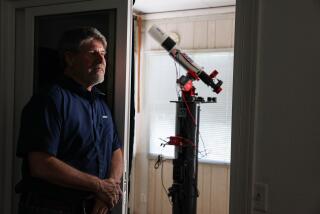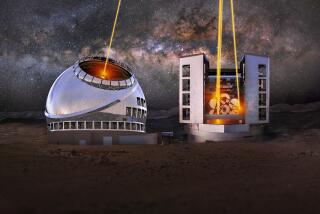Palomar Crew Charts the Skies to Develop Maps for Stargazers
- Share via
PALOMAR MOUNTAIN, Calif. — Astronomers here have begun charting the most detailed and far-reaching map yet of the heavens, to serve as the primary reference atlas of the northern sky for decades to come for world-class stargazers.
The project will take five to seven years and will involve the painstakingly slow process of taking 5,000 photographs or more of the night sky--each exposure lasting about an hour--and then making the best available to observatory libraries around the world, like so many pages of a celestial map book.
“There’s a lot of excitement in this because it’s the kind of mapping that Sir Francis Drake or Magellan may have done,” said Bob Brucato, assistant director of the Palomar Observatory. “This survey will be providing us views we haven’t seen before” of heavenly bodies, including clusters of distant galaxies.
Astronomical Discoveries Expected
Scientists at the major observatories in the Northern Hemisphere, as well as those working on the space telescope, will use the Palomar Sky Survey, as it is being called, to help them hone in, with more powerful telescopes, on specific targets in deep space for more detailed research.
The Palomar astronomers from Caltech, which owns and operates the observatory here in northern San Diego County, say they expect to make some astronomical discoveries of their own along the way. Not only will the new survey detect celestial objects that are several million times fainter than can be detected with the naked eye, but it will record for the first time objects that are four to six times fainter than detected in the last sky survey, holding the prospect of yielding never-before-seen galaxies, stars, quasars, asteroids and comets.
Furthermore, the astronomers expect to determine just how the structure of the Milky Way has shifted since the last sky survey was completed 30 years ago--also by Caltech astronomers and technicians at Palomar.
“In those intervening 30 years, all of the stars have changed position slightly. When we measure those changes, by comparing these plates with those of the first survey, it will reveal the motion of the stars. We will be able to collect an incredible body of data,” Brucato said.
“This will tell us a great deal about the dynamics and structure of our own galaxy, including how much mass is in it and how it is distributed. These are interesting and important questions to us.”
The survey is being made not with the observatory’s famous 200-inch Hale Telescope, but with the 48-inch Schmidt Telescope, a gigantic, high-powered, wide-field camera.
“Road Map’ for Study
Although the larger telescope can take scientists to the fringe of space and time, its field of view is so narrow that it would not be feasible to use it in photographing the entire sky. The Schmidt instrument, however, can photograph fields of 6 1/2 degrees, or about 13 times the size of the full moon.
“In a very basic sense, the survey by the Schmidt will be a road map from which we will select objects for our 200-inch telescope to study in further detail,” Brucato said.
When the project is completed, the 894 photographed fields will provide a composite portrait of the northern sky, as was done by the same telescope during the 1949 sky survey.
Two significant technical advances in astrophotography will, however, make the earlier survey obsolete, Brucato said:
- The Eastman Kodak Co. has developed improved photographic emulsions that will react not only to blue and red, as was the case in the earlier survey, but to near-infrared light as well. That, and a process of flushing the 14-inch-square glass photographic plates with nitrogen and hydrogen gases to remove oxygen and water molecules in the emulsion, will increase the sensitivity of the plates five-fold.
- A new $380,000 lens that is four feet in diameter was installed last year, combating an image-blurring phenomenon known as “chromatic aberration.”
Each of the 894 fields of space will be photographed three times--for red, blue and near-infrared, Brucato said.
To get the final 2,682 plates to make up the celestial map, Brucato expects astronomers to have to take 5,000 pictures or more because of such problems as flaws in the plates or emulsion, imperfect tracking on the 60-minute exposure or aircraft.
When Moon Is Dark
The photo sessions with the stars will occur, weather permitting, each night during the two weeks of the month when the moon is the darkest, Brucato said.
A computer will assist the astronomers by identifying the locations of the field centers to be photographed nightly, locking the telescope onto a reference star for each picture.
The telescope is equipped with an ultra-sensitive motor that will help it track the field during the entire exposure, to eliminate the blur of relative motion in the photo plate.
Scientists will immediately develop each $70 glass plate in an observatory darkroom, dry it and put a microscope to it to identify any flaws--and to give it a cursory examination for any new sightings.
“You’re never quite sure what will be there when you look at it,” Brucato said. It was during such a first-look at a plate, for instance, that Caltech graduate student Christine Wilson discovered a new comet--as large as Halley’s Comet--which now bears her name and which will be visible to the naked eye in the southern hemisphere next April.
Brucato said eight or nine exposures will be made every night under the best of conditions.
Later, scientists will compare the new plates with those made 30 years ago, not only to spot new sightings of more distant celestial objects never before seen by man but to compare the current relative position of known stars with their location in the earlier survey.
Glass, Film Slides
After the plates are inspected and catalogued, they will be stored in a vault on the Caltech campus in Pasadena. Glass or less expensive--and slightly lesser quality--film transparency copies of them will be made available, at cost, to astronomers around the world for research.
Because of its position, the Palomar Observatory’s survey will be only of the Northern Hemisphere. A similar survey of the southern sky is being made in Australia with the United Kingdom Schmidt Telescope, a virtual twin of the Palomar Schmidt instrument. Combined, the two surveys will provide astronomers with an all-encompassing sky map.
The Palomar study will cost about $1.5 million and is being funded by grants from the Alfred P. Sloan Foundation, the National Geographic Society, the National Science Foundation and the Eastman Kodak Co.






